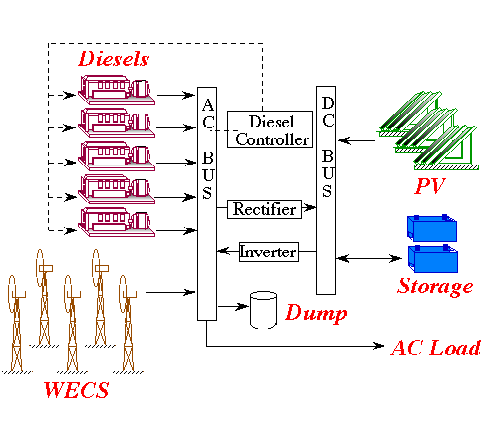
UW-HYBRID
PV/Wind/Diesel Hybrid Simulator

A detailed multiple-unit wind turbine performance simulator with selectable hardware,
A detailed diesel engine performance and fuel consumption model with selectable hardware,
A detailed PV module array system and peak power tracker performance model with selectable hardware,
A general diesel engine dispatch controller employing cost optimization algorithms,
Selectable time series weather data,
Selectable time series loads data, and
Various output formats, diagnostic calculations, summaries and measures of performance.
UW-HYBRID 1.0 includes a wind turbine performance model which accurately calculates the performance of a real wind turbine, based on data read in from a power curve file. Up to five different types of turbines can be included in the current version. The model includes the effects of elevation wind shear and time varying temperature and wind speed to calculate the appropriate performance of the wind turbine over time. Cumulative loss factors can be incorporated as well. The diesel engine performance model determines fuel output, fuel cost, power ou\ tput, engine hours and waste heat delivered over time as a function of controller setpoints. These calculations are made subsequent to reading in power output and fuel consumption performance specifications from files describing actual diesel systems. The PV performance model simulates the performance of a PV system at a user-specified array slope azimuth and module type. The calculations are based on data obtained from actual time series weather files for the location. The calculations of system performance utilize the methodologies developed at the Solar Energy Laboratory for calculating radiation on the tilted surface and net electrical power resulting from the system. A peak power tracker is included. The diesel engine dispatch controller can accept up to five generators in any sequence or configuration. The controller determines the net load to be provided by the diesels, by subtracting renewables output from the demand. The controller programs itself by reading the performance specification data used by the diesels to describe their operational characteristics. Subsequently, the controller determines the least-cost ranking of the units, and dispatches the diesels in a sequence which satisfy the criteria of minimum cost to meet load. The controller also determines the amount of dump energy per timestep. This occurs because the diesels cannot operate at less than their minimum load, typically 40%.